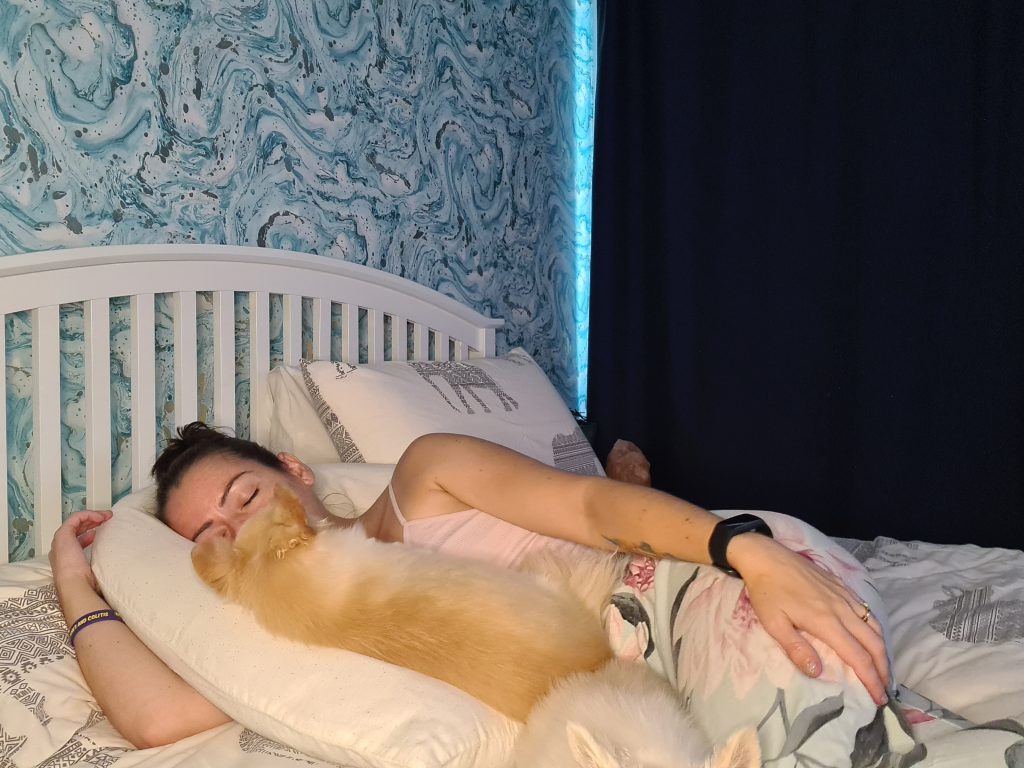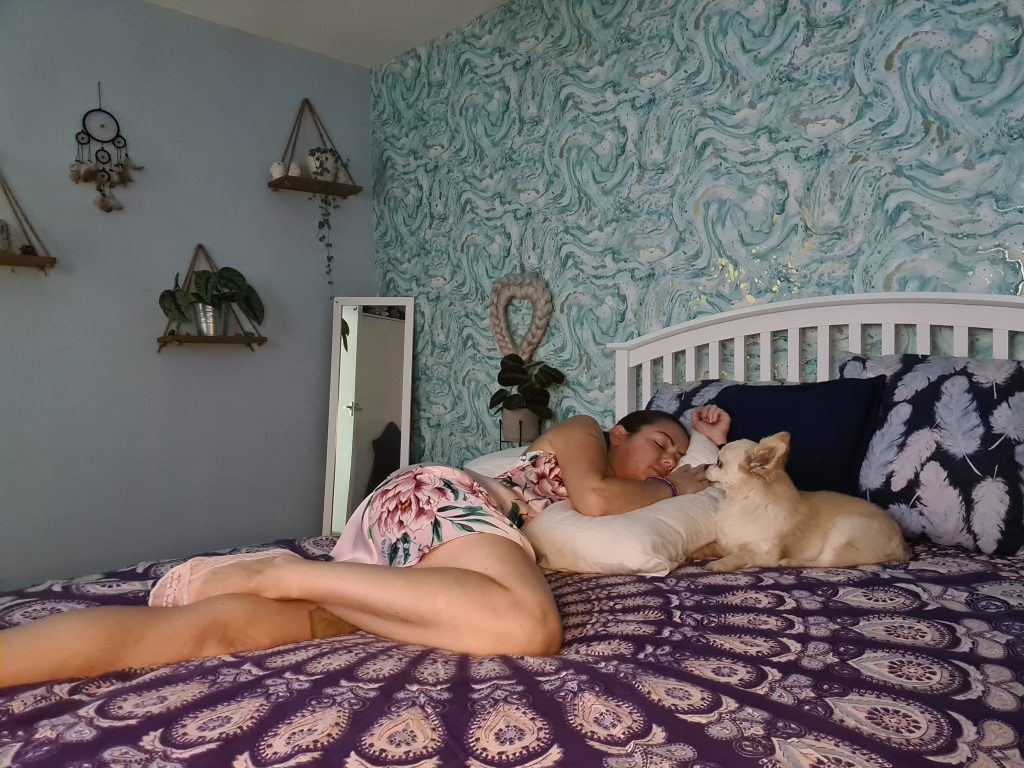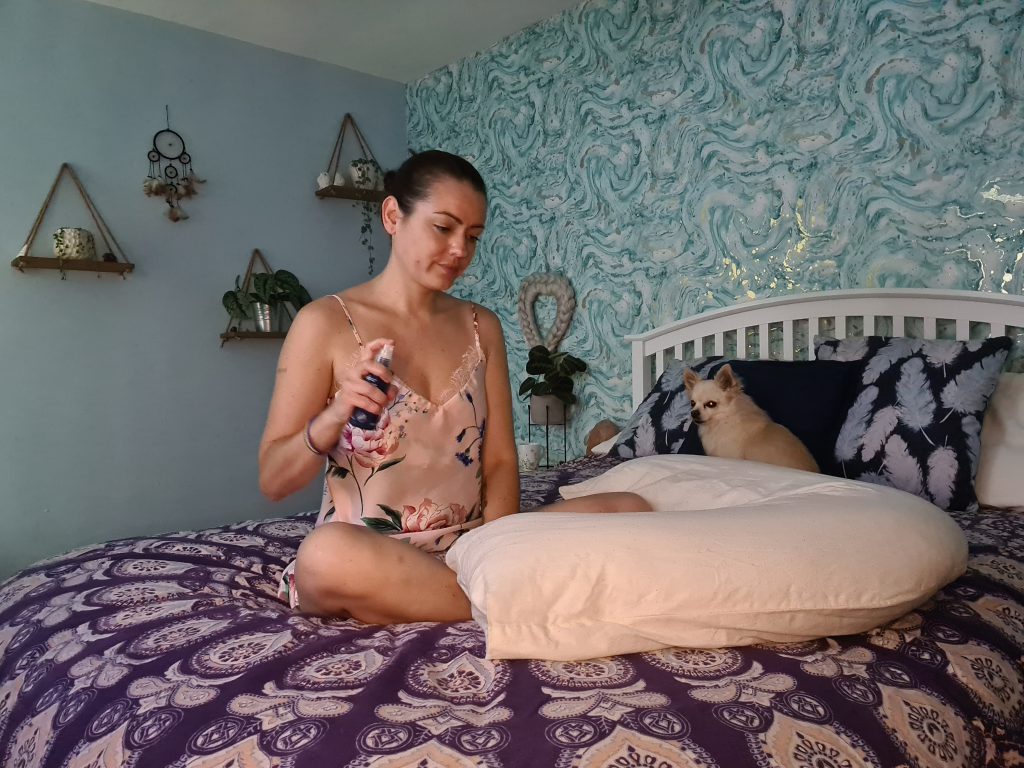
Getting a good night’s sleep when you have a colostomy, or ileostomy, can be challenging. Many issues can occur, from having to empty multiple times a night to having to adapt your sleeping position. Leaks can and do happen…
Night-time ostomy bag leaks
Many moons ago, 2007 to 2009, during my first period with an ileostomy, night-time leaks were a very regular thing. The stoma bag I wore had a really thick baseplate, which creased easily and then leaked. This meant I was up and down constantly in the night, afraid of having any amount of output in the bag at all. The same thing happened with the stoma I had in 2014. I did, however, have the sense to start sleeping on an incontinence pad, so if a leak did happen, I wasn’t changing the bed as well as sorting myself out.
Sleeping was one of the areas I was dreading the most when I realised that I was going to need another stoma, and for life this time. I was pleasantly surprised how far bags had come in just the last 4 years! The thinner baseplates are designed to bend and flex with your body, so they rarely crease. The bags I wear now are much more secure, so night-time leaks aren’t something I often have to deal with.
There was a period, after I switched to a healthier diet following surgery, when I began experiencing more frequent leaks. This was due to my output becoming watery. I already take lots of prescription anti-diarrhoeal medication, which you should always speak to a healthcare professional about before introducing. So, I tried some different foods recommended for thickening output, but the options were limited because I was also focusing on being healthy. None of these helped either. Foods that can help thicken up output include things like rice, pasta, cheese, oats, bananas, applesauce, smooth peanut butter, and marshmallows. I started using gelling sachets to thicken up the liquid output, and finally, all was well again!
Sleeping positions with a stoma
When I had my first stoma, I was scared to lay on it at all. I’ve since realised it’s not harmful to the stoma itself. I’ve had many a massage at this point, and laying on my stoma has caused no issues at all. Laying on your stomach may increase the chance of leaks if the stoma becomes active and the bag begins to fill up. There’s not really a way around this.
Ostomates usually know when the stoma is generally going to be active if they eat and drink at the same times every day. Knowing when it’s inactive may make it possible to sleep on the stomach for that period of time. People with a colostomy might find that they usually don’t have their bag filling up in the night, in which case it’s not a problem.
Some might prefer to simply avoid sleeping on their stomach. I very rarely sleep on mine. If you’re a heavy sleeper, and worry about rolling onto your stomach by accident, I’d recommend using pillows to prop yourself up. There are many different types of pillows which might help. V shaped, maternity, and wedge pillows can help you sleep on your side comfortably, without ending up flat on your stomach.

Because of my fibromyalgia, a long-term chronic pain condition, I don’t really have a comfortable position. People with fibromyalgia have a heightened sensitivity to pain, and often other stimuli. I can’t lay on either side for more than an hour without experiencing pain in my hips and shoulders, so I’m constantly turning over. I feel like a spit roast chicken! I can often get comfortable on my back, but I don’t like to stay there as I’m more likely to get leaks. Because my output is mainly very loose, and I wear a convex bag, when I’m on my back, output just sits in the dip around my stoma.
Constant toilet trips with a stoma
Getting up multiple times a night can be really frustrating. Some people just learn how their body works and plan mealtimes to cause minimal sleep disturbance. Antidiarrheal medications might help, which again, you’d need to talk to a healthcare professional about as they’re not suitable for everyone and might not necessarily help. Some people wear a larger capacity bag at night, but constant changes can strip the skin of its natural barrier layer, and therefore moisture, resulting in dry, and irritated skin. Plus, it’s always worth considering the cost to the NHS of two bag changes per day, in my humble opinion. If there’s another way, I’d recommend trying that first!
Between my bowel and my bladder, I’m usually up a minimum of three times a night!
Establishing a sleep routine
I know sleep is majorly important for me, particularly because of the fibromyalgia and IBD. I’ve tried and tested so many things over the years to find a routine that works for me; from supplements and herbal teas to certain foods thought to help promote a good night’s sleep. Because I wake up every hour, and have to get up so often, I go to bed at 9.30 every night. I try to include exercise and getting outside into my routine every day, which I do find helps me fall asleep faster. I like lavender and jasmine essential oils, creams, and pillow sprays, so I often use those to soothe me, too. I usually have very little energy by bedtime, but I usually do some gentle stretches and deep breathing, recommended to me by my physio before going to sleep.
All in all, I generally get 5.5 – 7.5 hrs sleep a night. I’d like more, but I’m not ready for an even earlier bedtime yet! Maybe in a few more years 😉

I hope you’ve found this post useful. We’d really like to hear about your experiences of sleeping with a stoma too! If you’d like to share your thoughts with me, you’ll find me on social media. If you want to talk privately, my inbox is always open.
We hope you enjoyed this article from our guest blogger. They are expressing their views or knowledge on a topic because of their experience & background. Some of the opinions expressed may not reflect the views of Fittleworth or your NHS professional.
It goes without saying, but this is not clinical advice. Each person will have an individual set of medical factors to consider. So please do not to make significant changes to your diet, exercise or treatments before consulting with an NHS professional.
Sahara was admitted to hospital and diagnosed with Ulcerative Colitis at the age of 19, after just two weeks of being incredibly unwell. One week later, she had emergency surgery to remove her colon and rectum, and had her first ileostomy. A turbulent journey followed; a multitude of treatments, complications, seven surgeries, a failed J-Pouch, and three ileostomies later, she is living with a permanent stoma and is a pro-active IBD and ostomy advocate.

Sahara Fleetwood Beresford – Ostomy Blogger
Sahara joined the online IBD and ostomy community in 2014, and it very quickly became apparent to her that whilst awareness is important, even more important than that is providing support to others as they navigate the stormy waters of life with IBD, or an ostomy.
She runs #IBDSuperHeroes fundraising and awareness campaign, and the Facebook support group. She is a blogger for InflammatortyBowelDisease.net and an IBD Patient Consultant for merakoi – bridging the gap between patients and healthcare. She gets involved with research whenever she can, and is a volunteer for Cure Crohn’s Colitis, where she donates her time and expertise in social media marketing and content creation.
